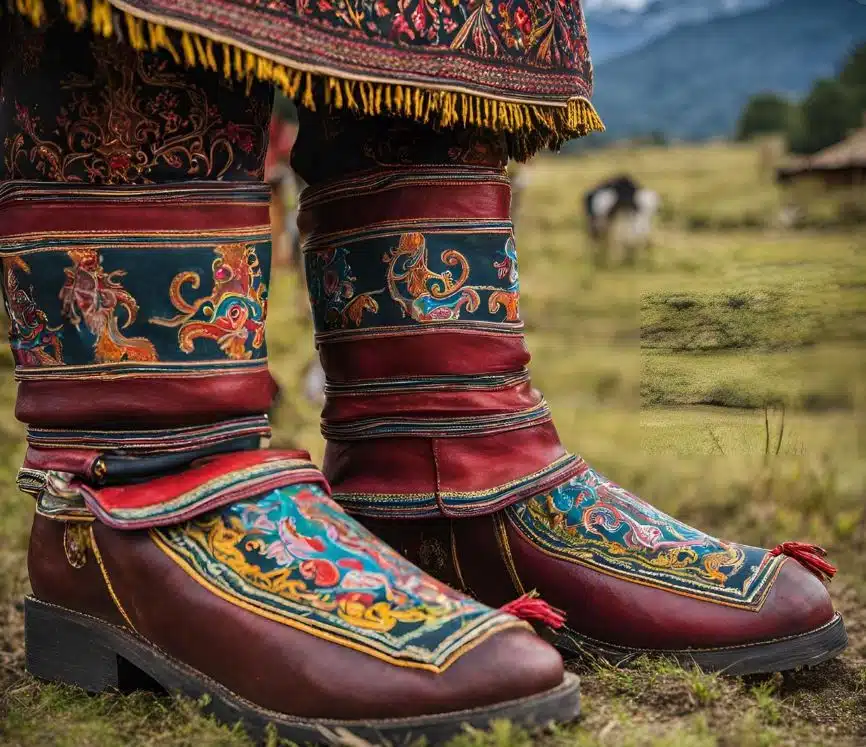The Seven-league boots

Written By Johanne Bernard
Blog | Culture and tradition | Dzogchen philosophy
In this article, Johanne invites us to step into the seven-league boots of our childhood tales, on the path of Dzogchen.
.
Series: The spiritual path in Dzogchen
Beginning the Dzogchen path
The Seven-league boots
We all remember the stories we were told as children… In these tales, handed down from generation to generation, there were stories of castles, princes and princesses, but also of wolves, ogres and dark forests… Snuggled up in bed with the blanket pulled up to our chins, half frightened, half reassured by the presence of the narrator, we listened attentively to these ancient tales and fell asleep repeating to ourselves their wise advice : never venture into the dark forest without being sure you can find your way back; best of all, scatter white pebbles along the way to guide you home. But are we reassured? Not really. Because there’s something the story didn’t tell us: even though we’re in our house, now that we’re grown up, we can’t fool ourselves any more. We know very well that there’s a dark forest all around us. We also know that a house is not as reliable as we thought: the roof can blow off, water can rise and flood it, war can destroy it, we can go bankrupt and lose it, we can lock ourselves up in it and it can become our own prison, we can also die in it, because yes, a house doesn’t protect us from death… “Does it really help to sow little pebbles?”, we might ask ourselves, as we become increasingly lucid about the illusory nature of our sense of security…
What about the path of the Dzogchen? Well, tradition tells us that sowing little pebbles is not really the way to take the path of Dzogchen, whose final practice is Thögal, ‘the immediate leap’. So, what should we do with these stories? Put them aside?
“… Perhaps the encounter with our own nature is just to discover that the house, the black forest and the white pebbles are manifestations of our own mind, the tales of our childhood”
Not necessarily. Because there is one element in these stories that we may have forgotten, but that deserves our attention: the seven-league boots. The Seven-league boots are magical boots that allow you to travel seven leagues in a single step, or about 21 miles according to the tales (which are very precise on this point). “Oh…this could be useful for the Dzogchen’s great leap!”. Seven-league boots have another peculiarity: even though they have been used by giants for centuries, and precisely because they have been used by giants for centuries, they adapt to the size of the wearer. “So anyone, even me, can wear them,” we think… And finally, these boots always lead us to the same place, no matter what path we take, in an instant. “Unbelievable… but it has to be verified,” we say, because we’re not children who are told stories anymore, are we? Well, yes, we can verify it, the tradition tells us, because from the introduction to the nature of mind to the practice of Thögal, everything passes through the experience of the natural state, its integration, its realization…
But there are many stories in Dzogchen… We could even say that everything we tell ourselves is a story for the Dzogchen. And I’d like to tell you one, a story about boots, the boots of a great master of Tibetan Buddhism from the 8th century: Padmasambhava… In those days, the traditional boots were beautifully embroidered with colourful threads and came up to the knees. Padmasambhava happened to be wearing a pair of these magnificent boots on his first visit to Bhutan, where, according to tradition, he arrived on the back of a princess transformed into a tigress. After subduing the demons and hiding a few termas, he left, leaving his boots behind. Considered a blessing, Padmasambhava’s boots have been preserved, from century to century and from master to master, right up to the present day. However, as everyone wanted to have a piece of these boots for protection and blessing, only one sole remained over the centuries, as small pieces of cloth were cut into small pieces of cloth from these magnificent boots. I remember that in Bhutan, in a valley near Paro, the master in charge of preserving the boots showed us the relic. To be sure of preserving this sole that remained, the master had locked it in a chest. And to make sure that no one could ask him for another piece, which as a friend of good he could not refuse, he had thrown away the key to the safe. However, there was still the possibility of receiving a blessing on the head from the chest containing the remains of the relic…
But let’s go back to the seven-league boots. In Dzogchen, putting on these boots means following in the footsteps of the master to get straight to the result. At first, we don’t know what this result is, but we are told that it is present at the Base. And without an introduction to the nature of mind, we don’t even know what it means to ‘follow in his footsteps’. Tradition tells us of an immediate leap. ‘Maybe we don’t even move,’ we say. Perhaps the encounter with our own nature, the primordial nature of our mind, takes place where we are. And putting on the boots is only to discover the illusory nature of a black forest as a place of danger, of a house as a refuge, of white pebbles as a way to get from one to the other… Perhaps the encounter with our own nature is just to discover that the house, the black forest and the white pebbles are manifestations of our own mind, the tales of our childhood.
The only way to find out is to try. Admittedly, the story of Padmasambhava’s boots tells us that there may only be a small piece of sole left to begin the journey and take the great leap… But there is still the possibility of doing it. And that’s far more extraordinary than any of our childhood tale.
More Posts
Oceanic Journeys
In « Oceanic journeys », Damien offers a tale that is a metaphor of the spirtual path according to the Great Perfection.
A Dive into the Luminescent Abyss of the Mind
In this article, Denis takes us to a place where, even in the heart of silent darkness, universal compassion continues to manifest itself.
High Tide, Low Tide
In “High Tide, Low Tide”, Johanne talks about the movements of the mind, by observing the natural tide cycle.





